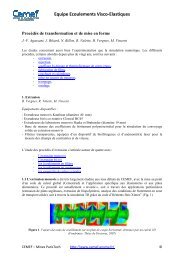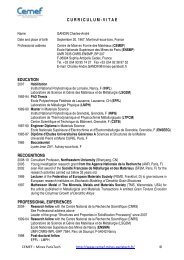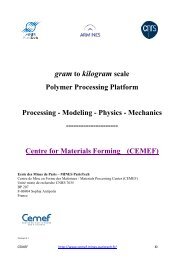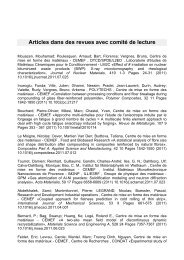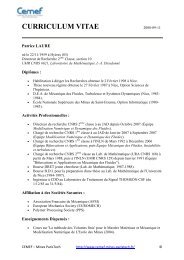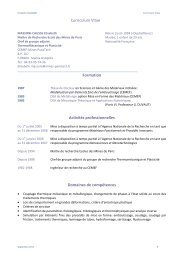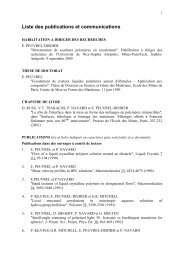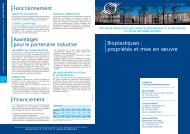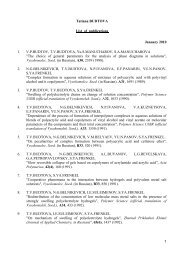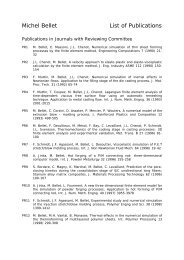Description .pdf - Centre for Material Forming (CEMEF) - MINES ...
Description .pdf - Centre for Material Forming (CEMEF) - MINES ...
Description .pdf - Centre for Material Forming (CEMEF) - MINES ...
Create successful ePaper yourself
Turn your PDF publications into a flip-book with our unique Google optimized e-Paper software.
<strong>CEMEF</strong><br />
<strong>Centre</strong> de Mise en Forme des Matériaux<br />
<strong>Material</strong>s <strong>Forming</strong> Center<br />
Polymer Chemical Physics Group<br />
Patrick Navard, Tatiana Budtova, Edith Peuvrel-Disdier<br />
August 2010<br />
Member of the European Polysaccharide Network of<br />
Excellence (EPNOE) and Carnot-Mines
Research areas:<br />
Physics and chemical physics of solutions,<br />
suspensions, blends, gels and other complex structures<br />
based on synthetic and biomass-based polymers.<br />
Physics and chemical physics of polysaccharides.<br />
Rheology and understanding of the influence of<br />
complex flows on the morphological organisation.<br />
Development of rheo-optical tools.
A- Cellulose and cellulose-based materials<br />
B- Bio-based polymers and bioplastics blends<br />
C- Filled polymers and composites<br />
• solutions,<br />
• blends,<br />
• suspensions,<br />
• micro-gels,<br />
• other complex polymer structures<br />
Rheology and rheo-optics are key techniques <strong>for</strong> studying structure evolution
A- Cellulose and cellulose-based materials<br />
Goals:<br />
To improve the use of cellulose, modify and make new materials<br />
• Understand dissolution mechanisms of cellulose coming from<br />
various sources<br />
• Study solution thermodynamics and rheology<br />
• Control cellulose regeneration<br />
• Prepare and process new materials<br />
• Model cellulose biosynthesis
B- Bio-based polymers and bioplastics blends<br />
Goals:<br />
• To understand the structures <strong>for</strong>med during the flow of<br />
immiscible bio-based polymer blends<br />
• To investigate flow and taste perception of starch<br />
suspensions via behaviour of one granule<br />
• To prepare new materials<br />
• To relate morphologies to properties<br />
Bio-based components are:<br />
• Starch<br />
• Cellulose derivatives<br />
• PHA, PLA, etc.
Goals:<br />
C- Filled polymers and composites<br />
To understand :<br />
• the physics of agglomerate and nanoparticle dispersion under<br />
flow<br />
• the relation between this process, final dispersion state, the<br />
processing and the final properties of materials<br />
• the properties of natural fibers-based composites<br />
• De<strong>for</strong>mation and controlled release behaviour of micro-gels<br />
Systems:<br />
- suspensions of nanofillers and agglomerates (silica, carbon black)<br />
- composites based on natural fibres rein<strong>for</strong>cing thermoplastics and lignin.<br />
- micro-gel particles
Summary of recent and present<br />
research projects
A- Cellulose and cellulose-based materials<br />
• Molecular dynamics of plant cell wall biosynthesis<br />
Fibers:<br />
Solutions:<br />
<strong>Material</strong>s:<br />
• Cellulose fiber swelling and dissolution<br />
• Influence of enzymatic and/or chemical treatments <strong>for</strong><br />
improving cellulose fiber processability<br />
• Physics of regenerated cellulose fibre<br />
• Cellulose-NaOH-water solutions<br />
• Cellulose-ionic liquid solutions<br />
• Ultra-light cellulose foams: preparation, structure and<br />
properties.<br />
• Carbonized cellulose <strong>for</strong> electro-chemical applications<br />
• Coating of cellulose surfaces
B- Bio-based polymers and bioplastics blends<br />
• Flow-induced structuring of incompatible biomass-based<br />
polymer blends<br />
• Flow-induced phase inversion in biomass-based polymer<br />
blends<br />
• Starch-polybutylene adipate-co-terephthalate (PBAT) blends<br />
• Flow and taste perception of starch suspensions, behaviour of<br />
one granule
C- Filled polymers and composites<br />
• Natural fibre – thermoplastics composites<br />
• Lignin-based composites<br />
• Dispersion of agglomerated fillers<br />
• Impregnation of polymers in agglomerated fillers<br />
• Clay-polypropylene nanocomposites<br />
• Microgels as delivery matrix <strong>for</strong> controlled release
A- Cellulose and cellulose-based materials
Molecular dynamics of plant cell wall biosynthesis<br />
Goal: to understand the organisation behaviour of cellulose<br />
fibres in the cell wall<br />
• How are cellulose chains organizing right after<br />
exiting from membrane?<br />
• What is the distance membrane – wall?<br />
• Is growth synchronised ?<br />
• What are the states right be<strong>for</strong>e crystallisation?<br />
Applications:<br />
- Optimisation of dissolution process<br />
- Understanding of activation<br />
- Search of new solvents<br />
Numerical simulation of the con<strong>for</strong>mations of six fibres<br />
exiting the plasma membrane during biosynthesis
Cellulose fiber swelling and dissolution<br />
(EPNOE and industrial consortium)<br />
Goal: to understand the swelling and dissolution of cellulose<br />
fibres and to relate them to the fibre morphology<br />
Dissolution behaviour of native cellulose fibres is controled by the existence of<br />
different walls made during biosynthesis. The picture shows how the primary wall<br />
rolls around a swelling secondary wall, making sort of balloons.<br />
Applications:<br />
- Optimisation of dissolution process<br />
- Search of new solvents
Influence of enzymatic and/or chemical treatments <strong>for</strong><br />
improving cellulose fiber processability<br />
(Industrial consortium)<br />
Goal: to improve and find new activations of cellulose pulp<br />
- treatment with Nitren (dissolution of xylan?)<br />
- enzymatic treatment (dissolution of the primary wall?)<br />
- influence of tension<br />
Pulp<br />
treatment, dissolution<br />
Swelling and dissolving in NaOHwater<br />
of treated cellulose fibres<br />
Insolubles<br />
Solubles<br />
• Yield<br />
• Sugar analysis<br />
• Mw distribution<br />
• Optical microscopy<br />
• Crystallinity<br />
• Intrinsic viscosity (Cuen)<br />
Applications:<br />
- Understanding of activation<br />
- Improve pulp quality
Physics of regenerated cellulose fibre<br />
(Direct industrial contract)<br />
Goals:<br />
- To<br />
understand the<br />
fibrillation<br />
mechanisms in Lyocell fibres.<br />
Fibrillated Tencel fibres<br />
- To study swelling and dissolution of<br />
a regenerated fiber.<br />
Applications:<br />
• textile fibres<br />
Waving of the unswollen core of a<br />
swelling Tencel fibre
Dissolution of cellulose in NaOH-water<br />
(Industrial consortium)<br />
Goals:<br />
- to understand cellulose dissolution in aqueous NaOH solutions;<br />
- to understand the influence of additives (urea(<br />
urea, ZnO) ) on the<br />
properties of cellulose-NaOH<br />
solutions (gelation(<br />
gelation, hydrodynamic<br />
properties)<br />
Cellulose+7.6%NaOH/H 2<br />
O<br />
Limit of cellulose dissolution in NaOH/H 2<br />
O:<br />
minimum 4NaOH per 1 AGU<br />
Applications:<br />
• sponges<br />
• beads<br />
• membranes
Cellulose-ionic liquid solutions<br />
(EU and French national projects)<br />
Goals:<br />
- To characterise the properties of cellulose-imidazolium<br />
imidazolium-based<br />
ionic liquid solutions: flow, visco-elasticity<br />
elasticity, solvent quality,<br />
comparison with other cellulose solvents.<br />
- To understand the influence of non-solvent<br />
addition: water,<br />
DMSO.<br />
140<br />
intrinsic viscosity, mL/g<br />
120<br />
100<br />
80<br />
60<br />
40<br />
20<br />
0<br />
Cellulose-EMIMAc<br />
Cellulose-BMIMCl<br />
0 50 100 T, °C<br />
Applications:<br />
• New solvents <strong>for</strong><br />
cellulose processing
Ultra-light porous cellulose: Aerocellulose<br />
(EC and French national project)<br />
Goal:<br />
to prepare highly porous cellulose from “green” solvents<br />
Cellulose dissolution (NaOH, ionic liquids)<br />
Samples of Aerocellulose prepared<br />
by Cemef and other partners<br />
Regeneration<br />
Drying in supercritical conditions<br />
Applications:<br />
Pores: 100 nm – 1µm<br />
Density: < 0.1 g/cm 3<br />
Porosity: 95-99%<br />
• Delivery/storage matrix<br />
• Medical<br />
• Insulation
New nanostructured carbons from Aerocellulose<br />
<strong>for</strong> electrochemical applications<br />
(French national project)<br />
Goal:<br />
to prepare highly porous, with a large specific surface,<br />
nanostructured carbons based on cellulose precursors<br />
pyrolysis<br />
Aerocellulose<br />
carbon Aerocellulose<br />
Applications:<br />
• primary batteries,<br />
• proton exchange membrane fuel cell<br />
• supercapacitors<br />
Density : 0.2-1 g/cm 3<br />
Porous volume: 0.2-4 cc/g]<br />
Average macropores diameter: 40-190 nm<br />
Specific surface BET : 70-500 m²/g<br />
Average micropores diameter : 2.4-6 nm
Coating of cellulose surfaces<br />
(EU project)<br />
Goals:<br />
- To understand the properties of<br />
cellulose-stabilised<br />
stabilised nano-particle<br />
suspensions.<br />
- To functionalise cellulose surfaces<br />
with<br />
polysaccharides and nano-<br />
particles, using « green » solvents.<br />
AFM: deposition of cellulose on a cellulose film<br />
Applications:<br />
• functionalised (e.g. anti-microbial, whiteness) cellulose fibers<br />
and films<br />
• modified cellophane barrier properties
B- Bio-based polymers and bioplastics blends
Flow-induced structuring of incompatible biomassbased<br />
polymer blends<br />
(Industrial Chair in Bioplastics, direct industrial contracts)<br />
Goals:<br />
- To prepare new materials by blending bio-based<br />
based polymers<br />
- To understand their morphology and final properties<br />
Blends of thermoplastics:<br />
- PLA-PHA,<br />
- cellulose esters-polyolefines<br />
Co-continous structure of a biomass-based polymer blend
Starch-polybutylene adipate-co-terephthalate<br />
(PBAT) blends<br />
(National project)<br />
Goal:<br />
• Thermoplastic starch rheology<br />
• Effect of processing parameters on the blend morphology<br />
• Relationship with mechanical properties of films<br />
100 kWh/t 230 kWh/t<br />
Applications:<br />
• New polymer materials<br />
• Mulch films<br />
• Biodegradable packaging<br />
SEM micrographs after dissolution of the starchy phase:<br />
Effect of specific mechanical energy
Flow-induced structuring of incompatible biomassbased<br />
polymer blends<br />
Goals:<br />
- to control de<strong>for</strong>mation, breakup and dispersion<br />
- to relate morphology evolution and rheology<br />
1.6<br />
(Industrial project)<br />
N 1<br />
/ N 1, eq<br />
σ / σ eq<br />
1.4<br />
1.2<br />
1<br />
0.8<br />
N 1<br />
σ<br />
0.6<br />
de<strong>for</strong>mation<br />
0.4<br />
0.2<br />
0<br />
rupture<br />
0 100 200 300 400 500<br />
Quantité de dé<strong>for</strong>mation<br />
Applications:<br />
• tailoring blend properties<br />
Rheological behaviour of a HPC solution in PDMS blend
Flow-induced structuring of incompatible model<br />
polymer blends<br />
(EC project)<br />
Goal: to control elementary mechanisms : coalescence<br />
The lower is the shear rate:<br />
- the larger is the final size<br />
- and the slower is the<br />
coalescence.<br />
This is due to the time needed to<br />
eject the fluid layer:<br />
Applications:<br />
• tailoring blend properties<br />
Diameter (µm)<br />
14<br />
12<br />
10<br />
8<br />
6<br />
4<br />
2<br />
0<br />
0<br />
1% PDMS in PIB<br />
0,3 s -1<br />
1 s -1<br />
3 s -1<br />
Strain<br />
units<br />
40000 80000 200000
Flow-induced phase inversion in biomass-based<br />
polymer blends<br />
(Industrial project)<br />
Goals:<br />
- To<br />
prepare<br />
new<br />
materials<br />
by<br />
inverting<br />
the morphology of blends<br />
- To<br />
understand<br />
phase<br />
inversion mechanisms<br />
B<br />
Increase of concentration of A<br />
B A<br />
B<br />
A<br />
B<br />
Polymer A<br />
Viscosity<br />
η<br />
A<br />
Φ<br />
⋅<br />
η Φ<br />
B<br />
Shear<br />
?<br />
B<br />
A<br />
⎧><br />
1<br />
⎪<br />
⎨=<br />
1<br />
⎪<br />
⎩<<br />
1<br />
Phase B continuous<br />
Co-continuity<br />
Phase A continuous<br />
A<br />
B Polymer B<br />
Shear rate<br />
η A /η >1<br />
Β<br />
B continuous<br />
η A /η
Microgels as delivery matrix <strong>for</strong> controlled release<br />
(French national project)<br />
Goal:<br />
- to understand the controlled release from soft gels, synthetic and<br />
natural, under shear<br />
Example: release of a solution of linear polymer under shear stress<br />
dry gel<br />
particle<br />
placed into an oil<br />
+<br />
under shear stress<br />
polymer<br />
solution<br />
swollen gel<br />
particle<br />
Applications:<br />
• cosmetics, pharmacology, food<br />
released solvent<br />
The same was found <strong>for</strong> alginate and carrageenan micro-gels, chitosanalginate<br />
capsules and swollen starch granules
Flow and taste perception of starch suspensions<br />
Goal:<br />
- To understand the behaviour of one starch granule and of<br />
starch suspension under flow.<br />
- To correlate with taste perception.<br />
Droplet of a concentrated suspension:<br />
Droplet of a dilute suspension:<br />
Volume fract: ~ 100%<br />
Volume fract: ~ 10%<br />
100µm<br />
100µm<br />
100µm<br />
100µm<br />
Applications:<br />
• food
C- Filled polymers and composites
Natural fibre – thermoplastics composites<br />
(Industrial Chair in Bioplastics)<br />
Goals:<br />
To understand:<br />
- fiber rupture during processing;<br />
- influence of fiber type on the rheological properties of<br />
composites<br />
- influence of fiber treatment on composite properties<br />
a<br />
b<br />
Applications:<br />
• composite materials<br />
Rheo-optical observation of Tencel (a) and flax (b) fibers rupture
Lignin-based composites<br />
(Industrial Chair in Bioplastics)<br />
Goal:<br />
- to use lignin as a matrix <strong>for</strong> making structural materials<br />
Use of lignin and lignin derivatives<br />
to glue natural fibers<br />
Preparation of lignin-based<br />
nanocomposites<br />
Lignin-flax composites<br />
Applications:<br />
• bio-based composites, bio-based polymer fillers
Dispersion of agglomerated objects<br />
(Different projects: EC, national, industrial)<br />
Goals: - to understand elementary mechanisms of dispersion<br />
- to predict dispersion during mixing<br />
Dispersion mechanisms<br />
of carbon black<br />
in SBR under shear:<br />
Rupture<br />
If τ > τ c<br />
c =<br />
f<br />
( ) R 0<br />
Erosion<br />
τ (<br />
Very slow<br />
3 3<br />
Erosion<br />
R<br />
0<br />
− R<br />
t<br />
= α τ − τC<br />
) γ&<br />
t<br />
Applications:<br />
• tyre manufacturing<br />
• filled polymers<br />
Effect of concentrated medium<br />
SBR matrix filled with glass beads
Infiltration of polymers into porous systems<br />
Goal: to understand the influence of impregnation on dispersion<br />
R=R 0<br />
50<br />
R=0<br />
R<br />
(µm)<br />
40<br />
30<br />
20<br />
t R<br />
t infilt<br />
t 0 t 1<br />
t 2 >t 1<br />
0<br />
SBR infiltration in a silica agglomerate<br />
10<br />
To understand the physics behind infiltration:<br />
- role of molecular weight,<br />
- role of agglomerate organisation,<br />
- role of filler/matrix interactions.<br />
0 2 4 6 8<br />
t (h)<br />
Infiltration kinetics<br />
Applications:<br />
• tyre manufacturing<br />
• filled polymers
Clay-polypropylene nanocomposites<br />
(EC project)<br />
Goal: To understand - flow-induced<br />
structuration<br />
- relation with processing<br />
Multiscale structure :<br />
Nanocomposite: PP/PP-g-MA/organoclay<br />
Nanoscale:<br />
Microscale:<br />
Normalized Stress<br />
1,3<br />
1,2<br />
1,1<br />
1<br />
0.1 s-1<br />
1 s-1<br />
5 s-1<br />
0,9<br />
0 5 10 15 20<br />
Strain<br />
Light scattering pattern of the<br />
nanocomposite under shear<br />
Transient behaviour of the nanocomposite<br />
<strong>for</strong> different shear rates<br />
Applications:<br />
• New polymer materials<br />
• Automotive sector
<strong>CEMEF</strong><br />
www.cemef.mines-paristech.fr<br />
www.epnoe.eu



